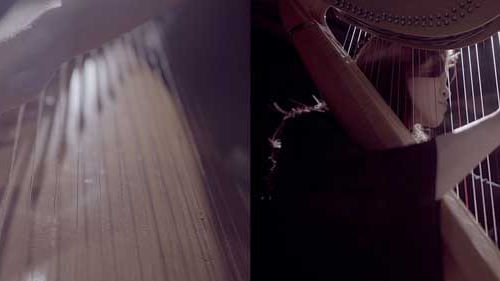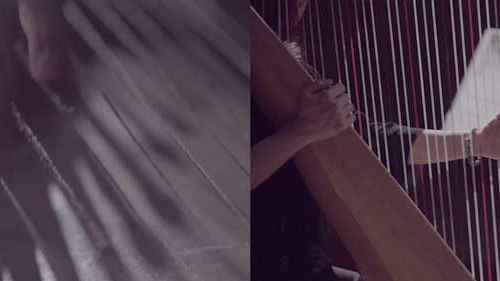Sojung Jun
Eclipse Ⅰ, Ⅱ
Sojung Jun
Eclipse Ⅰ, Ⅱ
—
2020, Two-channel video & Sound, 10min 27sec
2020, Two-channel video & Sound, 13min 25sec
In the Seventh Night, a notable Korean folktale, Jiknyeo – a daughter of a heavenly king had a daughter – and Gyeonwu – a young herder – that fell in love could cross the Milky Way in between and not meet each other. They were allowed to meet only once a year, which falls on July 7 because the king was furious over their relationship. Then, crows and magpies worked together to form a bridge across the Milky Way for the couple, and their once-a-year encounter could take place.
The ‘Double Concerto’ (1977) by composer Isang Yun (1917-1995) is a song where the above folktale was used as an analogy for the inter-Korean relationship. The national division into North and South Koreas after the Korean War in 1945 is still valid now in 2020 well after 1977 when the song was composed, which visualizes the two’s as unfathomable and vague relationship as the distance of the Milky Way, and the psychological and physical boundaries of people within.
Countless crows and magpies connecting the couple through the Milky Way are reminiscent of the gestures of hostility and hospitality tried out between the two Koreas, and experiences of success and failure in cultural, political, social and personal exchanges. Just like the endless flapping crisscrossing the senses of despair and expectations that are still ongoing.
Eclipse Ⅰ, Ⅱ is a two-channel video documenting of two music “Fragments” and “Seventh Night” composed for the North Korean gayageum (a Korean traditional zither with 12 strings) and the harp. Works of Eclipse Ⅰ, Ⅱ contemplate on the present with motifs from the life and music of Yun Isang who was heart-broken in the sheer reality of national division as he dreamed of a single nation.
Around the two instruments both making sounds with strings are two camera men working in two different trajectories to reflect the players. The two men’s movement of reflecting or shooting the players creates an illusion like a shadow play or choreography through the external light being projected. The video moves the coordinates by creating horizontal and vertical movements.
The two clips with a different speed in Eclipse Ⅱ bypass and meet each other again and again by drawing two different trajectories. The endlessly sliding images create mirror-like images and end up being synchronized shortly. The horizontal and vertical movements repeatedly happening in the frame reveal the changes in views of either hiding or exposing the objects, and grasp an instantaneous and momentary consensus.
*The North Korean gayageum modified to have 21 strings came into being with the Russian influence in the 60s and 70s when the pentatonic scale as the basis for the Korean traditional music was expanded into the diatonic scale commonly found in classical music. The instrument was designed also to enable the skill of nonghyeon (various vibrations and hand movements exerted on the string) for the traditional 12-string gayageum widely used in South Korea.
Sojung Jun
Eclipse Ⅰ, Ⅱ
—
Videos
Year: 2020
Durations:10min 27sec / 13min 25sec
Two-channel video & Sound
Videos produced by the Han Nefkens Foundation
BIOGRAPHY
Born 1982, South Korea
Works in South Korea
Introduction of the Songs
Fragments for North Korean Gayageum and Harp (2020)
This song is composed by using tiny fragments that refer to a bar or a tune in the ‘Double Concerto’. The little fragments end up weaving the differences from the original piece thanks to the free movements in the song. Each element is involved in the entire composition, yet forming a holistic and autonomous integration, just like the four imaginary animals in the Four Guardian Deities (sashindo). Freedom in harmony with differences in the commonality of musical notes is offered through the intersection of the gayageum and the harp, and the traditional gayageum and the retrofitted North Korean version.
Seventh Night for North Korean Gayageum and Harp (2020)
Focusing on the therapeutic power of the folklore of the Seventh Night, this song partially quotes the diatonic scale and chords in the ‘Double Concerto’. Emotions of individual people in the national division are categorized into seven parts in this piece where the busy intersection of seven pedals in the harp and the triple repetition of the 21 strings in the North Korean gayageum, unfolding seven dream-like scenes.
The moment of Gyeonwu and Jiknyeo in the last scene is momentary, and their dance is analogous to the dance of a warrior filled up with sadness and tension in contrast with waiting for long.
Introduction of the Participating Artists
North Korean gayageum player Soona Park, was born in Japan, and studied gayageum from former Korean traditional music masters that went to North Korea at the National Pyongyang Music and Dance College (currently, Kim Won Gyun Pyongyang Music College), and graduated from the School of Korean Traditional Arts at Korea National University of Arts with a master’s degree, and also studied under Korean traditional music masters. Park is mainly active in South Korea as a gayageum player crisscrossing the cultures of Pyongyang, North Korea, Japan and Korea. She worked in Geumgangsan Theater Troupe as the only group of artists in Korea to perform abroad, and is also a member of KOTOHIME, a gayageum ensemble, in Asia.
Harpist Junkyung Bang acquired a diploma at the Ecole Normale de Musique de Paris / Alfred Cortot(France). She played the Focus on Youth at The 7th World Harp Congress in Praha, while winning the first prize at the Monthly Music Competition and Seoul National University Competition while at school. Having returned home, she collaborated with Daegu Symphony Orchestra, Wonju Symphony Orchestra and Seoul Chamber Ensemble.
Composer Jiyoung Kim acquired a doctoral degree at the College-Conservatory of Music, University of Cincinnati. She won prizes in Seattle International Composition Competition, Dvorak Composition Competition and German International Choir Composition Competition. She also entered the finals for the Minnesota Orchestra Composition Contest, and took part in the concert for the Midwest Composers Symposium.
Composer Soojung Shin majored in composition at Mozarteum University in Austria. She won many prizes including Theodor Körne Prize, Paumgartner Medal, GEDOK Competition and DAAD Artist Program. She also released her works in many music festivals including Warsaw Autumn Festival, Darmstadt Summer Festival and the Korean Orchestra Festival.
Born in Korea, Isang Yun studied at the Paris Conservatory in France. He came to be spotlighted in the European musical circles by releasing《Music for Seven Instruments》which has the Korean jeongak (meaning “proper music” in Korean) tonality along with the chromatic scale at the Darmstadt International Contemporary Music Festival (Internationale Ferienkurse für Neue Musik in Darmstadt) held in Germany in 1959. He visited North Korea in 1963 to see the Four Guardian Deities from Gangseodaemyo which was the motif for his work <Image>(1969). He was imprisoned for two years after being abducted and taken to Seoul on the fabricated charge of spying in the East Berlin Incident, but was later set free thanks to the public movement to save him in the global music community. He was naturalized as a German citizen in 1971, and left about 150 pieces of work.
He has been acclaimed for “expressing East Asiatic images through the Western contemporary music techniques” and “combining the playing techniques for the Korean music with Western musical instruments.”





